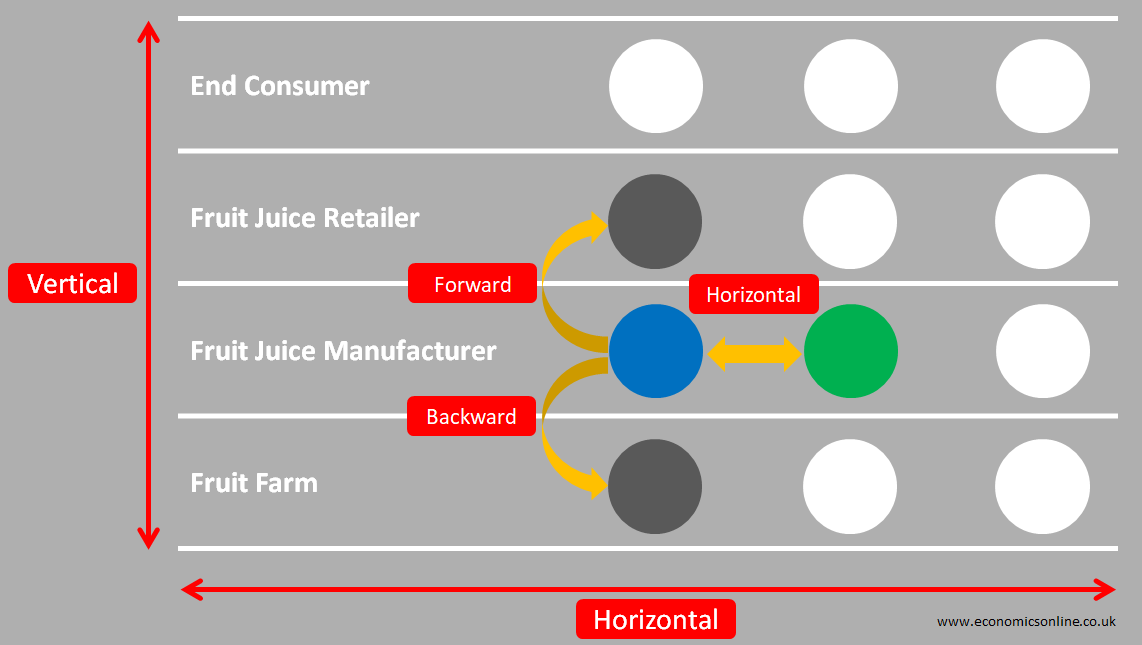
An image showing integration through joining hands.
Vertical Integration
What is Vertical Integration?
Vertical integration is a business strategy that involves the takeover or merger between two firms in the same industry at a different stage of production. In other words, "vertical integration" is a business strategy where a company owns or controls different stages of the supply chain. These stages can include everything from raw material extraction to final product distribution.
This strategy is used to increase the size of a business, i.e. business growth.
Basic Terms
Before explaining vertical integration in detail, let’s look at some basic terms of this topic.
Business Growth
Business growth means an increase in the size of a business over a period of time. Business growth can be of two types: internal growth and external growth.
Internal Growth
Internal growth, or organic growth means an increase in the size of a business within its existing operations without a merger or takeover.
External Growth
External growth or integration means an increase in the size of a business through a merger or takeover. External growth can take place through mergers or takeovers.
Merger
The joining of two firms to make them one is called a merger. Owners of both firms agree to join their firms together.
Take-over (Acquisition)
The purchase of the ownership of one business by another business is called a "takeover or acquisition".
Vertical Integration and Horizontal Integration
Vertical integration and horizontal integration are two common business strategies used by firms to achieve growth and competitive advantage. While both strategies involve business growth, they differ significantly in terms of the direction of growth and objectives.
Vertical integration involves merging with or acquiring another firm in the same industry but at a different stage of production. On the other hand, horizontal integration involves merging with or acquiring another firm in the same industry and at the same stage of production.
The objective of vertical integration is to improve efficiency and control costs, while the objective of horizontal integration is to increase market share, market power and reduce competition.

Types of Vertical Integration
There are two types of vertical integration: forward integration and backward integration.

Forward Vertical Integration
It is a growth strategy where one firm merges with or takes over another one in the same industry but at a later stage of production, closer to the consumer. In other words, it involves a business firm taking control of the distribution and marketing of its products. For example, a manufacturer of sports equipment may acquire a retail store to sell its products directly to consumers.
Backward Vertical Integration
It is a growth strategy where one firm merges with or takes over another one in the same industry but at an earlier stage of production, i.e., closer to suppliers or raw materials. In other words, it involves a business firm taking control of the production of its inputs. For example, a car manufacturer may acquire a steel mill to ensure a stable supply of steel for its cars.
Benefits of Vertical Integration
Vertical integration can result in several advantages for a business, including:
1. Increased Efficiency
Vertical integration can improve efficiency by eliminating the need for transactions between different companies. For example, a car manufacturer that owns a steel mill does not need to negotiate prices or delivery schedules with a separate steel supplier.
2. Higher Profit
Vertical integration can also result in higher profits by eliminating the markup of intermediaries. For example, a manufacturer that owns its own distribution channels can avoid the cost of intermediaries such as wholesalers and retailers because the markups previously given to the wholesalers or retailers are kept by the firm. Similarly, the profit previously given to the suppliers can be kept by the business if it has its own supplying firm. Moreover, firms can also enjoy the benefits of synergies and economies of scale.
3. Improved Quality
Vertical integration can improve quality by allowing a company to oversee every stage of the production process. For example, a restaurant that grows its own vegetables can ensure that they are fresh and free of pesticides.
4. Greater Control
Through vertical integration, a firm can have better control over its inputs, components, marketing, and distribution of products. For example, a restaurant that grows its own vegetables will have better control over the supply of vegetables in terms of prices and timely deliveries. Similarly, having its own distribution channels means that not only will a business have an assured outlet for its products, but the company can also prevent the outlet from having competitors’ products.
5. Greater Career Opportunities
A vertically integrated business will have greater career opportunities for workers, not only in the same production unit but also in supply and distribution businesses. This will improve the career choices of workers and may make them loyal and satisfied.
Drawbacks of Vertical Integration
Despite its benefits, vertical integration can also have disadvantages, including:
1. Reduced Flexibility
Vertical integration can reduce a company's flexibility to respond to changes in the market. For example, a car manufacturer that owns its own steel mill may find it difficult to switch to a new supplier if market conditions change.
2. Increased risk
Vertical integration can increase a company's risk by tying it to a particular production process. For example, a restaurant that relies on its own vegetable farm may be vulnerable to crop failures or pests.
3. Lack of Experience
Lack of experience in running a supplying business or a distribution outlet may affect the performance of the business negatively, leading to a loss of focus and reduced profitability. Moreover, the business may become complacent because it has an assured supplier and a guaranteed customer base for its products.
Impact of Vertical Integration on Stakeholders
Workers may have greater and varied career opportunities along with higher job security because the business has a supply setup as well as secure outlets.
Consumers may obtain improved quality and more innovative products, but they may resent the lack of competition in the retail outlet because of the withdrawal of competitor products.
Shareholder impact depends on whether profit rises or not. An increase in profit may make the shareholders happy.
Examples of Vertical Integration
There are many examples of companies that have successfully implemented vertical integration. For example:
1. Tesla
Tesla is a vertically integrated company that produces electric vehicles and solar panels. The company controls every stage of the production process, from the mining of raw materials to the final assembly of its products.
2. Amazon
Amazon is a vertically integrated company that controls the entire supply chain of its products. The company owns its own distribution centres, delivery trucks, and even its own planes.
3. McDonald's
McDonald's is a vertically integrated fast-food chain that controls every aspect of its operations, from the sourcing of ingredients to the training of its employees.
Conclusion
Vertical integration can be a powerful business strategy that results in several benefits, including increased efficiency, lower costs, and improved quality control. However, it can also have drawbacks, such as reduced flexibility and increased risk. Companies must carefully consider the potential benefits and drawbacks of vertical integration before deciding to implement this strategy. By doing so, they can make informed decisions that promote sustainable and profitable growth.

